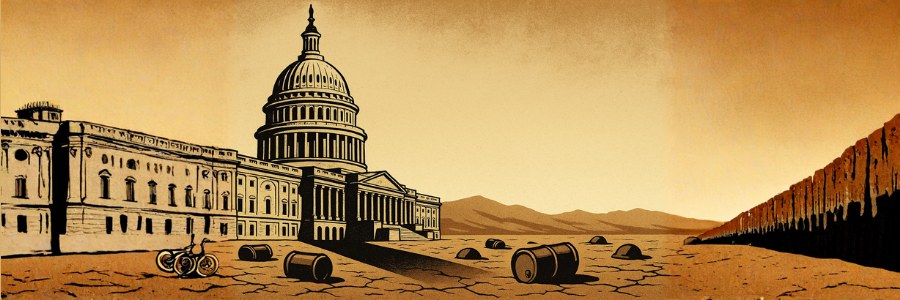
Posted November 11, 2025
By Sean Ring
The Good, The Bad, and The Ugly
It’s been quite a year for those of us who kept the faith.
In 2025, the precious-metals complex has exploded higher, wiping the smug smirk off every CNBC talking head’s face.
Gold is again above $4,100 an ounce, silver’s knocking on $51.00, and the long-suffering, undervalued, under-owned miners, who’ve finally had their day in the sun, have restarted their rally.
That’s the good.
But there’s more to this story than ticker triumphs. This rally is rooted in the same fiscal and monetary dysfunctions that got us here in the first place. Those same distortions have made gold soar… and they’re about to make life a lot more expensive again.
That’s the bad.
And then there’s the ugly—a brand-new round of populist stimulus, this time in the form of “tariff dividends,” that threatens to reignite consumer price inflation just as metals investors start to breathe easy.
Let’s unpack it all.
The Good: The Great Metals Revival
Gold is up 58% year-to-date, its best performance since the U.S. closed the gold window in 1971. Silver’s even more impressive, surging 76.25% to its highest nominal level ever recorded in dollars.
Not a random blip, it’s the culmination of a multi-year process where institutional capital, central banks, and retail investors have (maybe, mercifully) come to the same conclusion: paper promises aren’t worth much when governments print money to oblivion or recklessly shower the population with it.
Mining stocks have led the charge. The global gold and silver mining indices have doubled in 2025, with GDX returning over 120% year-to-date.
Market capitalization for the mining sector has ballooned to nearly $1 trillion—more than triple the five-year average. And yet, miners still account for less than 0.5% of global equity markets. That’s right: 0.43%. The upside potential if institutional allocators simply return to historical weighting levels is staggering.
Operationally, the numbers tell the same story. First Majestic Silver reported a 96% year-over-year jump in output and a third consecutive quarter of record revenue. Agnico Eagle, Coeur, and Hecla are reporting the kind of profits that make tech stocks jealous.
And unlike the “growth stories” of Silicon Valley, these firms are producing tangible, in-demand assets that governments themselves are hoarding.
Because make no mistake: the biggest buyer in the room isn’t Reddit retail. It’s the central banks.
The fear of a weakening U.S. dollar, negative real yields, and escalating geopolitical risks are driving central banks to diversify their reserves faster than at any time in modern history. Russia and China have led the charge. But even Western central banks, such as Poland’s, are topping up their vaults.
Private investors are following suit, seeking a hedge against systemic risk, currency debasement, and the kind of political volatility we used to associate only with emerging markets.
Gold and silver aren’t trades so much as refuges.
The Bad: The Scarcity and the Math
Now here’s the catch: what’s driving this rally is not prosperity—it’s pathology.
The same dysfunctions that make gold and silver shine are slowly eroding the foundation of the global economy.
Let’s start with the fiscal math.
Major economies, led by the U.S., are running structural deficits that simply don’t add up. As interest costs rise, so do the deficits—forcing new borrowing that raises interest costs further. Economists call it “the impossible fiscal equation.” It’s a death spiral.
Washington’s debt service alone has crossed $1.5 trillion annually. That’s more than the entire defense budget. To keep the machine running, policymakers have no choice but to issue new debt and monetize it through the Fed. In other words, create money to pay the interest on the money already created.
Yes, it’s legalized counterfeiting.
The result? The same monetary debasement cycle that’s been repeating for centuries—except this time, it’s global. Europe, Japan, and China are all engaged in a synchronized devaluation, pushing real yields further into negative territory and forcing investors to seek protection in tangible assets.
Metal scarcity only adds fuel to the fire.
After a decade of underinvestment, regulatory gridlock, and ESG-driven capital flight, new mine development is at multi-decade lows. It now takes an average of 15–20 years to bring a major gold or silver project from discovery to production.
Meanwhile, industrial demand for silver—especially in solar panels, electric vehicles, and electronics—has surged beyond available supply. The Silver Institute estimates a 250-million-ounce deficit this year alone.
It’s simple economics: less supply and more demand equals higher prices.
This is why precious metals have outperformed every other resource class by a significant margin.
When the world’s policymakers debase their currencies while starving real production, gold and silver become the last honest measures of value left standing.
That’s why this rally feels different. It’s no speculative mania, but a capital flight from the fiat system itself.
The Ugly: “Tariff Dividends” and the New Inflation Wave
Just when you think Washington might take a breather from breaking the economy, along comes a fresh populist brainstorm. Well, more a braindrizzle than a brainstorm: the $2,000 Tariff Dividend.
President Trump has floated a plan to send $2,000 checks to most Americans, financed by tariff revenues.
Sounds familiar? It should. It’s a rebranded version of the COVID-era stimulus, dressed up in red-white-and-blue economic nationalism. And it’ll have the same result: it’ll drive consumer price inflation to the moon.
According to Bloomberg, the proposal would cost $600 billion—roughly double the government’s total annual tariff revenue, which the economists’ consensus expects to be only $300 billion for calendar year 2025. In other words, Washington would need to borrow to pay out money supposedly financed by tariffs.
If that makes no sense, congratulations—you’re paying attention.
The administration’s defenders call it a “dividend,” suggesting that tariffs are generating enough new national wealth to share with citizens. But we’ve still not recovered from the inflation generated in 2021-2022 from the previous stimulus checks. Yes, price levels are still above those before the stimulus checks came.
The inflationary loop works as follows: the government sends checks, consumers spend, the supply chain tightens, prices rise, the Fed responds, rates increase, and deficits worsen. And that’s assuming the Fed is allowed to tighten if inflation gets out of hand.
The OECD and several U.S. think tanks estimate that a universal $2,000 payout in the current environment could raise CPI by 2–3 percentage points within months, particularly in energy, food, and—ironically—hard assets like metals.
In other words, the policy meant to help working Americans would erode the purchasing power of those same Americans.
Politically, the motivation is clear enough. Inflation remains the top concern among voters. Politicians want to look like they’re “doing something” to ease the pain—preferably something that arrives by direct deposit before election season.
But it’s macroeconomic madness. Every new round of fiscal stimulus, whether labeled “rescue,” “relief,” or “dividend,” digs the same hole deeper. The more Washington spends, the more the Fed must monetize, and the faster real yields fall.
And you already know what happens when real yields fall.
Gold and silver go vertical.
The Bigger Picture: What’s Really Happening
Here’s the uncomfortable truth: The “good,” “bad,” and “ugly” aren’t separate stories—they’re chapters of the same book.
The Good—our gold and silver gains—exists because of The Bad: chronic fiscal mismanagement, systemic scarcity, and policy distortion.
And The Ugly, another wave of stimulus disguised as populist relief, is the next logical step in a political system addicted to spending and inflation.
That’s why precious metals aren’t just hedges—they’re barometers.
When gold soars, it’s not celebrating prosperity. It’s diagnosing a disease. It’s telling us the patient—the global financial order—is running a fever.
Every metric confirms it.
- Gold: up 58% YTD, blasting through every technical ceiling.
- Silver: up 76.25%, with industrial demand exceeding mine supply.
- Miners: 100%+ annual gains, yet still a rounding error in global equity markets.
- Deficits: $1.78 trillion in 2025 versus $1.82 trillion in 2024. Not exactly progress, is it?
- Policy: unanchored, unserious, unsustainable.
Final stage monetary regimes accelerate the flight to real assets amid the pretense of stability.
And yet, for those who prepared, it’s vindication.
While mainstream pundits called gold “a barbarous relic,” those of us who saw the writing on the wall recognized that in an era of negative real returns, only scarcity, integrity, and physical reality retain value.
And if you need any more conviction for holding onto your metals and miners positions, listen to what Doug Casey has to say about it. It’s inspiring.
Gold and silver represent financial truth in a world of political fiction.
Wrap Up
So, yes—the rally’s been magnificent. That’s The Good.
But it’s built on the ruins of a system that can’t stop debasing itself. That’s The Bad.
And when the next round of “free money” hits mailboxes—tariff-funded or otherwise—the inflation cycle will spin again. That’s The Ugly.
The beauty of gold and silver is that they don’t care who’s in office or what signatures are on the checks. They respond only to math and to human nature—the two constants politicians can’t rewrite.
As long as governments insist on destroying their own currencies to buy short-term popularity, precious metals will remain the last refuge of sanity in an insane world.
And that’s why, for investors who understand what’s really going on, The Good represents justice in a mismanaged world.

This Edition Belongs to You
Posted November 14, 2025
By Sean Ring

An Open Letter to President Trump
Posted November 13, 2025
By Sean Ring

The Trap China Set For America
Posted November 10, 2025
By Sean Ring

The Lakes of Storm and Steel
Posted November 07, 2025
By Byron King

The Start of the Metals Rebound?
Posted November 06, 2025
By Sean Ring

